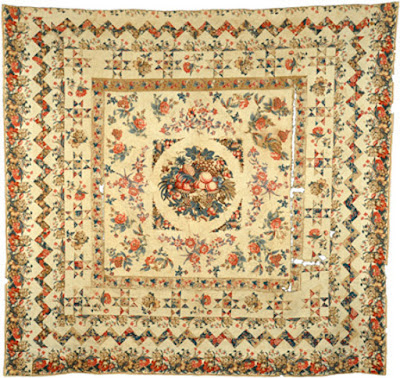I was doing a post on this floral stripe chintz a few days ago when I digressed into the topic of identifying the Auricula primrose on the Floral Motifs on Early Chintz website.
But I was supposed to be focused on this stripe and its many appearances in quilts
in the U.S. and the U.K.
The British Quilters Guild collection includes the Fife Coverlet frame quilt, found at a fleamarket in Fife, Scotland. It's attributed to the 1830s. Around the central panel is the floral stripe with bouquets of primroses (Auricula).
The floral border surrounds a center panel
(Makower reproduced the center about five or six years ago.)
http://www.quiltmuseum.org.uk/collections/heritage/fife-coverlet.html
Even if its history wasn't known we'd guess this was a quilt from the U.K. by the succession of pieced frames and in particular the use of rectangles, a British style characteristic that Americans
didn't often use. Americans developed different styles.
One American style: Central Stars. This one was
once in the McCarl's collection and is now in Jane Lury's as far as I know.
It is interesting how the quiltmakers often preserved the thin
geometric stripe to make a final fine border.
Another star quilt was documented by the Massachusetts project...
... now in Anita Loscalzo's collection.
The Quilt Index file notes that the print in the corners, the "calla lily" motif appears in several other quilts and that it is a "Match to accompany Broderie Perse floral." Perhaps a pair of prints for a Sheraton style chair?
Sheraton's illustration of a chintz upholstered chair about 1800
Bouquet on the chair seat's top, stripe around the edge?
A little Photoshopping
(actually a lot of Photoshopping)
Read more about Sheraton style chintzes
Quilt collectors and historians are calling this print calla lily,
iris or Mexican shellflower chintz. It is often seen in chintz applique
(Broderie Perse) quilts from about 1830-1860.
It is interesting how often the calla lily and the stripe appear in the same quilt.
See a post on the calla/Mexican shellflower print here:
Second star quilt documented by the Massachusetts project featuring both the calla bouquet and the floral stripe.
Switching styles:
Collection of International Quilt Study Center & Museum #2008_040_0019
From the Dillow Collection
The border stripe is the final border as it often is.
Again we have quilts in similar style, fabric and pattern.
Quilt attributed to slaves, Pearlington, Mississippi, 1830s.
Museum at Michigan State University
Fruit panel in the center and this border stripe along the edge.
The last medallion was donated by Linda Bell, who received it as a gift. Much more is known about this one than any of the others as Bell also donated "a letter from the donor, a letter written by the donor's great grandmother describing the family history, 2 pages of genealogy chart, marriage certificate, two pages of will of a family member, two pages from a publication citing family history."
Obvious similarities in the two medallions with pieced borders are the nine-patch stars (BlockBase #1631) alternating with applique. In the IQSCM border the stars alternate with appliqued hexagons; in the other with small cut-out chintz florals.
Most of the examples in my photo files are chintz applique medallions.
Collection of International Quilt Study Center & Museum
#1997_007_0306
From the James collection.
Includes both stripe and calla lily print with 11 repeats of the calla,
maybe from Baltimore.
International Quilt Study Center & Museum #2006_003_0002
With the equally popular fruit basket panel in the center.
No calla lilies.
Quilt attributed to the Boyle Sisters of Petersburg, [West] Virginia
Collection of Colonial Williamsburg.
The outside border. The central panel is the fruit again.
The Boyle sisters were professional quiltmakers.
See a post about their quilts here:
Style changed in the 1840s as conventional applique in block format replaced the fashion for chintz.
Quilt attributed to the Calvert family of Maryland, 1841, made for Ella Calvert by the midwife attending her birth at Riversdale near Bladensburg, Prince George's County. Collection of the Maryland Historical Society. [Ella Calvert Campbell is also reported to have been born in 1840 in Baltimore.]
The Calvert quilt seems to be a transition piece
between old fashion and new with conventional applique
of Turkey red and green calico alternating with chintz bouquets.
The Calvert quilt also contains both the calla lily bouquet and the floral stripe.
From the Maryland project and their book
A Maryland Album
The Carroll County quiltmakers who stitched this 1845 album for Joseph Rinehart used the stripe floral as an old-fashioned border on a cutting-edge new style.
Made in New Jersey, International Quilt Study Center & Museum.
#1997.007.0628
I haven't seen a reproduction of the stripe under discussion, but Petra Prins has something similar in her current Barnsley collection.






























Thanks for identifying that calla lily bouquet. Pieces of it appear frequently in Anna Catharine Hummel Markey Garnhart's quilts.
ReplyDeleteBeautiful examples of amazing work!
ReplyDeletePetra Prinz' Barnsley starter kit looks like tons of fun.
I wonder if she sells to the States?
Thanks for sharing Barbara.
I enjoy your blog posts.
ReplyDeleteKarmen